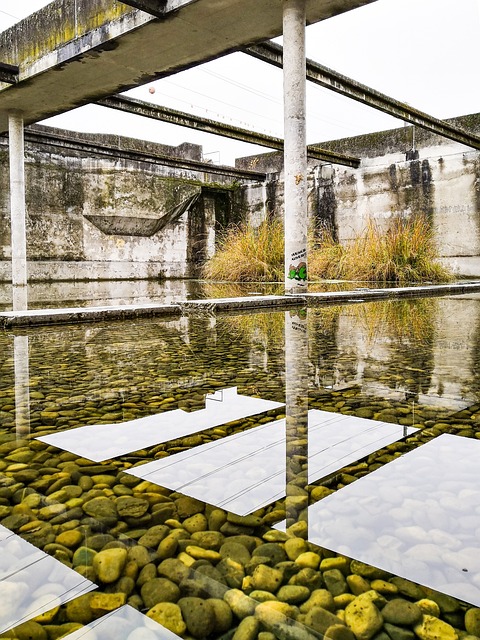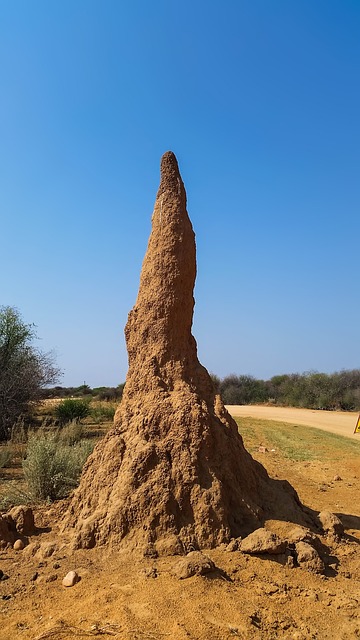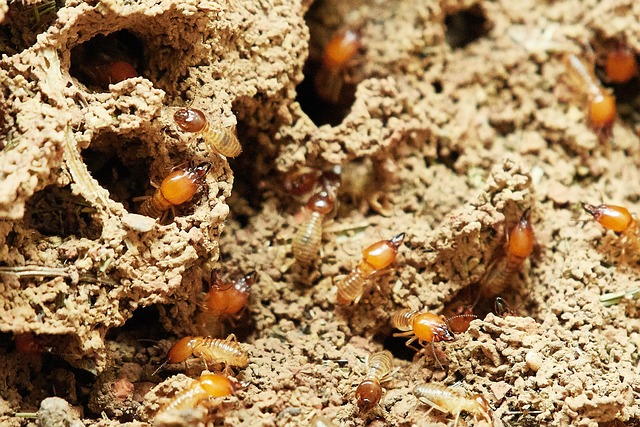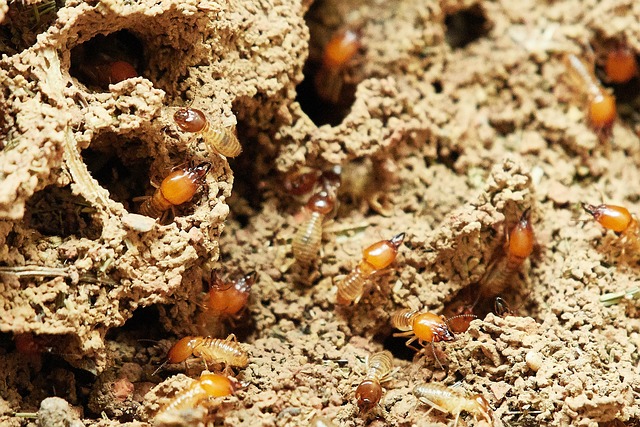Termites pose significant risks to properties worldwide, with species and climate influencing their behavior and damage. Effective termite treatment requires understanding local problems, habits, and food sources. Signs of infestation include visible wood damage, tunnel patterns, and insect swarms near entry points. Regular inspections are crucial for prompt action. Treatment options include chemical pesticides, non-chemical alternatives like termiticides and physical barriers, and natural predators like nematodes. DIY methods vs. professional services debate highlights advanced techniques, experience, and long-term protection benefits of professionals. Eco-friendly methods like using natural predators, organic termiticides, heat treatment, and baiting systems minimize ecological disruption. Prevention through regular inspections, sealing gaps, proper drainage, and using termite-resistant materials is key to avoiding significant structural damage. Treatment costs vary based on infestation size, property type, and method, with preventative measures proving more cost-effective. Post-treatment maintenance includes keeping properties in good repair, sealing entry points, removing debris, ensuring proper drainage, and periodic assessments. Global termite management varies due to climate and species differences, necessitating tailored local strategies for successful termite treatment.
Local termite control is a crucial aspect of home maintenance, addressing an insidious problem that can cause significant structural damage. Understanding your region’s specific termite issues is key to effective prevention and treatment. This article guides you through identifying infestation signs, exploring various termite treatments, and comparing DIY options with professional services. We also delve into eco-friendly solutions, cost analyses, post-treatment care, and regional differences in termite management, empowering you with knowledge for proactive protection against these persistent pests.
Understanding Local Termite Problems

Termites are a common pest in many regions, and their presence can pose significant risks to local properties. Understanding the specific termite problems in your area is the first step towards effective termite treatment. Different regions have distinct species and climates that influence termite behavior and the damage they cause. For instance, drywood termites are more prevalent in warmer, drier areas, while subterranean termites are found across diverse environments but prefer moist conditions.
Local knowledge about termite habits and the types of wood or materials they prefer to feed on is crucial for targeted termite treatment. Some regions might have unique construction methods or materials that attract termites, making it essential for homeowners and professionals to stay informed. By identifying these local factors, you can develop tailored strategies to protect your property from these destructive insects and ensure long-lasting structural integrity.
Identifying Signs of Termite Infestation

Termites can cause significant damage to homes and structures, making early detection crucial for effective termite treatment. Identifying signs of an infestation is the first step in protecting your property. One of the most noticeable indications is visible damage to wood, such as walls, floors, or furniture, where termites have chewed through them. Termites leave distinctive patterns of tunnels and holes, often appearing as faint lines on wooden surfaces.
Additionally, swarms of small insects around windows or doors during spring and summer could be an early warning sign. These are typically winged termites, sent out by the colony to find new areas for expansion. Other subtle signs include peeling paint, warped doors or windows, and a musty odour. Regular inspections, especially in humid climates known for termite prevalence, can help property owners stay ahead of these destructive pests, ensuring prompt termite treatment if necessary.
Common Types of Termite Treatments

When it comes to local termite control, understanding the common types of treatments available is essential for effective pest management. The most widely used methods include chemical and non-chemical approaches. Chemical termite treatments involve applying pesticides specifically designed to target and eliminate termites. These can be in the form of liquid barriers, where chemicals are injected into the soil around structures, or baits, which attract termites with a substance they cannot resist.
Non-chemical alternatives, on the other hand, offer eco-friendly solutions. These methods include termiticides that disrupt termite communication networks and physical barriers like metal or polymeric membranes. Some companies also utilize natural predators like nematodes to control termite populations. Each treatment type has its advantages and is chosen based on factors such as the local climate, building materials, and the extent of the infestation.
DIY vs Professional Termite Control

Many homeowners wonder whether they should tackle termite control on their own or hire a professional for effective termite treatment. While DIY methods can be appealing due to cost savings, professional termite control offers several advantages that ensure long-lasting protection.
Professional exterminators have extensive knowledge and experience in identifying and eliminating termites effectively. They utilize advanced techniques and tools tailored to specific termite infestations, providing fast and efficient results. Regular inspections and maintenance plans offered by professionals are crucial for early detection of any new infestations or reoccurrences, which can save significant structural damage costs in the long term.
Environmentally Friendly Termite Solutions

In today’s world, where environmental consciousness is on the rise, many homeowners are seeking eco-friendly solutions for pest control, including termite treatment. Traditional methods often rely on toxic chemicals that can have adverse effects on both the environment and non-target organisms. However, modern advancements in termite management offer safer alternatives. One such approach involves using natural predators like certain types of ants or introducing beneficial microorganisms to disrupt the termite colony’s feeding patterns.
These environmentally friendly termite solutions not only minimize ecological impact but also promote a more sustainable and holistic approach to pest control. Organic termiticides derived from plants or essential oils can effectively repel termites without leaving harmful residues. Additionally, heat treatment methods and targeted baiting systems allow for precise application of controls, reducing the need for widespread chemical usage. Such innovative termite treatments cater to environmentally conscious individuals while ensuring their homes remain protected against these insidious pests.
Prevention Strategies for Termite Damage

Termites can cause significant structural damage to homes and buildings, making effective termite control crucial for homeowners. Prevention is key when it comes to termite treatment, as it’s often more cost-effective than mitigation after an infestation. Regular inspections are a primary preventive measure; identifying potential entry points and signs of termite activity early can stop infestations before they become severe.
Sealing gaps in walls, floors, and foundations with appropriate materials can deter termites from gaining access to structures. Additionally, maintaining proper drainage around the property and removing decaying wood or other cellulose-rich materials nearby can reduce attractants for these pests. Using termite-resistant building materials and ensuring proper ventilation in crawl spaces further strengthens defenses against termite damage.
Cost Analysis of Termite Treatment Options

When considering local termite control, one of the most important factors is understanding the cost analysis of various treatment options. Termite treatment costs can vary greatly depending on several factors, including the size and severity of the infestation, the type of property (residential or commercial), and the specific method of treatment chosen. For example, traditional chemical treatments, while effective, can be more expensive than non-chemical methods like baiting systems.
It’s crucial to compare quotes from multiple termite control providers to get a clear picture of costs. Additionally, evaluating long-term expenses—such as maintenance and follow-up treatments—is essential to make an informed decision. Remember that prevention is often cheaper than cure, so investing in regular inspections and early treatment can save you significant money in the long run.
Post-Treatment Care and Maintenance

After a thorough termite treatment, proper care and maintenance are essential to ensure long-term protection against these pests. It’s crucial to understand that this is not a one-time solution but an ongoing process. Regular inspections are key; schedule periodic assessments to identify any potential reinfestation early on. These checks allow for prompt action if needed, preventing extensive damage.
Maintenance involves keeping your property in good repair, sealing entry points, and removing organic debris nearby, as termites are attracted to moist wood and plant matter. Proper drainage systems should be in place to prevent water buildup, which attracts termites and facilitates their breeding. Regular upkeep not only extends the life of your treatment but also contributes to a pest-free environment.
Regional Differences in Termite Management

Termite management varies greatly across different regions due to variations in climate, species, and local ecosystems. What works as a reliable termite treatment in one area might not be effective or practical in another. For instance, the southeastern United States is known for its high humidity and warmer temperatures, which favor termite proliferation. As such, professional treatments here often involve soil applications of termiticides, along with wooden structure modifications to prevent access.
In contrast, drier regions like the southwestern US pose unique challenges. Here, termites are less abundant but may be more deeply burrowed into the ground. Effective termite treatment in these areas might focus on targeted spot treatments using non-repellent termiticides or bait systems that attract and eliminate termites without harming nearby vegetation or pets. Local climates thus play a crucial role in dictating the most suitable termite management strategies.
